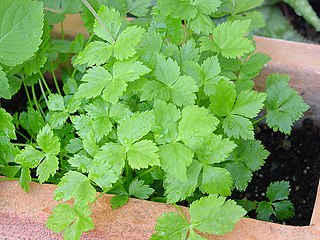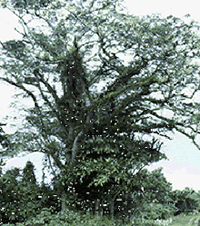
Cryptotaenia, or honewort, is a genus of herbaceous perennial plants, native to North America, Africa, and eastern Asia, growing wild in moist, shady places.

Serianthes nelsonii is a large tree endemic to Guam and Rota of the Mariana Islands. Only one mature tree exists on Guam, while 121 mature trees have been identified on Rota since 1984.

A species that is extinct in the wild (EW) is one that has been categorized by the International Union for Conservation of Nature as only consisting of living members kept in captivity or as a naturalized population outside its historic range. Classification requires exhaustive surveys conducted within the species' known habitat with consideration given to seasonality, time of day, and life cycle. Once a species is classified as EW, the only way for it to be downgraded is through reintroduction.

Serianthes is a genus of flowering plants in the family Fabaceae. It includes 17 species of trees and shrubs which range from Thailand and Malesia to Papuasia and the South Pacific. New Caledonia has the greatest diversity of species, with six endemic species. Typical habitats include tropical rain forest, scrub forest, coastal scrub, and rarely open wooded grassland.
Serianthes margaretae is a species of flowering plant in the family Fabaceae. It is found only in New Caledonia.
Serianthes myriadenia is a species of flowering plant in the family Fabaceae. It is a tree native to the Pacific Islands, including New Caledonia, Vanuatu, Tonga, and French Polynesia.
Serianthes petitiana is a species of flowering plant in the family Fabaceae. It is found only in New Caledonia.
Couratari calycina is a species of woody plant in the family Lecythidaceae. It is found only in Guyana.

Carallia calycina is a species of plant in the family Rhizophoraceae endemic to Sri Lanka.
Gesneria calycina is a species of plant in the family Gesneriaceae. It is endemic to Jamaica.
Ixora calycina is a species of flowering plant in the family Rubiaceae. It is endemic to Sri Lanka.

Palicourea is a genus of flowering plants in the family Rubiaceae. It contains 694 species, which range from shrubs to small trees, and is distributed throughout the New World tropics.
Palicourea calycina is a species of plant in the family Rubiaceae. It is endemic to Ecuador.

Ternstroemia is a genus of flowering plants in the family Pentaphylacaceae. It is distributed in tropical and subtropical regions in Africa, Asia, and the Americas.
Ternstroemia calycina is a species of flowering plant in the family Pentaphylacaceae. It is endemic to Jamaica, where it is known only from Cockpit Country. It is considered endangered.

Correa calycina, commonly known as the South Australian green correa or Hindmarsh correa, is a species of tall, dense shrub that is endemic to a small area of South Australia. It has papery, oblong leaves and pendulous green flowers arranged singly on the ends of short side branches.
As of July 2016, the International Union for Conservation of Nature (IUCN) lists 238 conservation dependent species. 0.29% of all evaluated species are listed as conservation dependent. The IUCN also lists seven subspecies and five varieties as conservation dependent.
Cape Blanche Conservation Park is a protected area located on the west coast of Eyre Peninsula in South Australia about 25 kilometres south of Streaky Bay. It was proclaimed under the National Parks and Wildlife Act 1972 in 2012 for the purpose of protecting ‘important breeding habitat for the eastern osprey and white-bellied sea-eagle ’ and ‘diverse range of flora’ including ‘the West Coast mintbush ,’ and to provide ‘provide important habitat for threatened shorebirds and migratory birds, including the hooded plover, sooty oystercatcher(Haematopus fuliginosus) and sanderling .’ The conservation park is classified as an IUCN Category III protected area.
Diclinanona calycina is a species of plant in the family Annonaceae. It is native to Brazil, Colombia, Peru and Venezuela. Ludwig Diels, the German botanist who first formally described the species using the basionym Xylopia calycina, named it after its well-developed calyx.
Cyanea calycina is a flowering plant in the Campanulaceae family. The IUCN has classified the species as critically endangered. It is native to the Hawaiian Islands. An example is being monitored with a plant cam.








